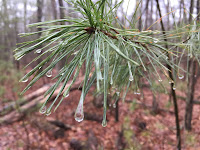 It was wet in the woods the other day. Actually, I think this was two or three weeks ago now--it's been quite busy lately and I lose track of the time. Spring had arrived and everything was alive. Even the spiders were out. I could hear the stream that runs down the hill to the reservoir. In places where the evergreens were thickest, the forest didn't look all that different in the spring as it did in the midst of winter. But the maples and the oaks and the birches and hickories were starting to leaf out and it was easier to see which trees had died over the winter, opening up patches in the canopy. On the ground beneath them, you could see seedlings ready to take over. On the part of the trail where it's widest and there seems to be the most sunlight, small hemlock saplings, no more than a foot or two high, had sprung up along each side of the path. Further up the trail, the giant hemlocks stood, many of them over a hundred feet tall by the look of them, and stately--they seemed to have no need for spreading branches to establish their places like the spruce trees or the balsam pines.
It was wet in the woods the other day. Actually, I think this was two or three weeks ago now--it's been quite busy lately and I lose track of the time. Spring had arrived and everything was alive. Even the spiders were out. I could hear the stream that runs down the hill to the reservoir. In places where the evergreens were thickest, the forest didn't look all that different in the spring as it did in the midst of winter. But the maples and the oaks and the birches and hickories were starting to leaf out and it was easier to see which trees had died over the winter, opening up patches in the canopy. On the ground beneath them, you could see seedlings ready to take over. On the part of the trail where it's widest and there seems to be the most sunlight, small hemlock saplings, no more than a foot or two high, had sprung up along each side of the path. Further up the trail, the giant hemlocks stood, many of them over a hundred feet tall by the look of them, and stately--they seemed to have no need for spreading branches to establish their places like the spruce trees or the balsam pines. |
| In the first technique of Seiunchin, both arms are initially brought up to the outside of the attacker's arm. |
 |
| The initial counter from the first sequence of Kururunfa. |
For example, in the opening move of Seiunchin kata—and in fact in many of the other techniques of this kata—both arms are brought to the outside of the opponent’s attacking arm, whether we see this attack as a wrist grab or a punch or a grab of one’s clothing. If one were to continue the sequence, the defender’s left hand would rotate in order to grab the attacker’s left wrist as the right forearm was brought down on the attacker’s elbow. This is the position in kata that looks like two down blocks in shiko dachi (horse stance) done at a 45 degree angle.
However, if one is thinking about variations, it is easy to see how the defender might move from this initial position in Seiunchin kata to the first attack in Kururunfa kata. The defender need only maintain contact with his right arm on the attacker’s left arm, releasing the left grab, and bring the left forearm up into the neck of the attacker. This is then followed by a left knee kick.
 |
| Continuing with this technique from Seisan kata by dropping the left arm and stepping in behind the opponent. |
But if these counter attacks are somehow thwarted, the defender can then tack on the first technique in Seipai kata (though it would be from the non-kata side), with the left forearm brought up alongside the neck, since the initial straight arm technique begins from this position with the elbow or forearm attacking the opponent’s face or neck.
Or, by dropping the left forearm down along the back of the opponent’s left arm and moving to the back, the defender could continue with the bridging and finishing techniques from the first sequence of Seisan kata.
Or, once to the back of the opponent, the defender could grab both shoulders, as we see in Saifa kata, and pull the attacker down onto the knee and attack with the hammer fist strike.
Or, by dropping the left forearm down along the back of the opponent’s left arm and moving to the back, the defender could continue with the bridging and finishing techniques from the first sequence of Seisan kata.
 |
| Continuing with the pull down technique from Saifa kata. [Me with Bill Diggle from photos we did for the book, The Kata and Bunkai of Goju-Ryu.] |
I think it is important to see the connections, but we can only really be comfortable with these kinds of connections when we understand the sequences of a kata and see the themes or principles contained within them. Once we are able to do that, the attack becomes relentless, sort of like the attack of the wooly adelgid on these stately Hemlock trees, I think.

